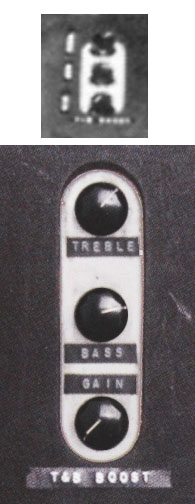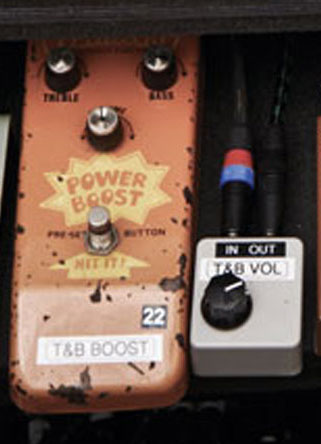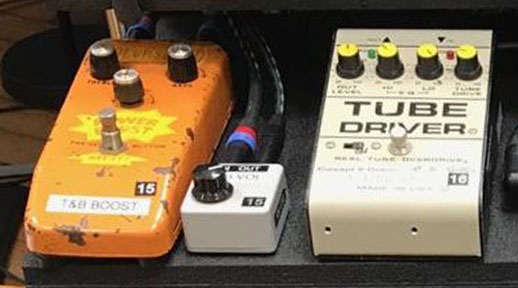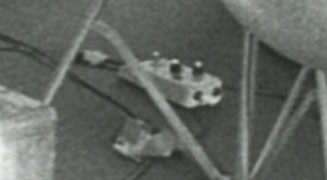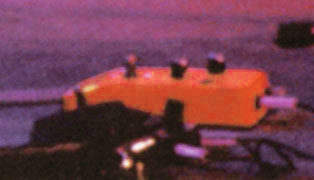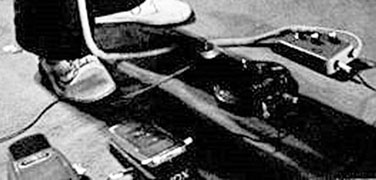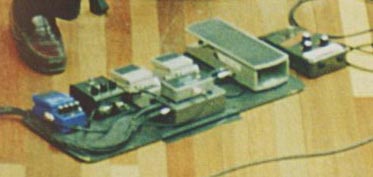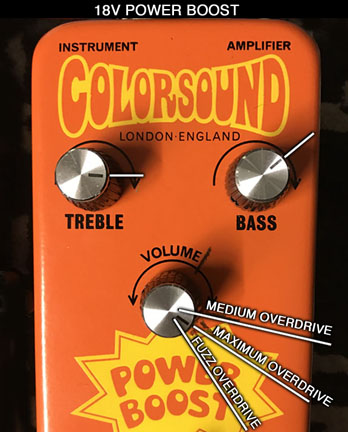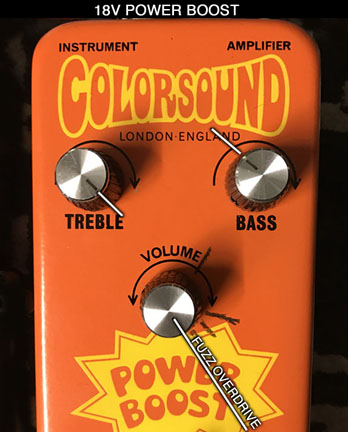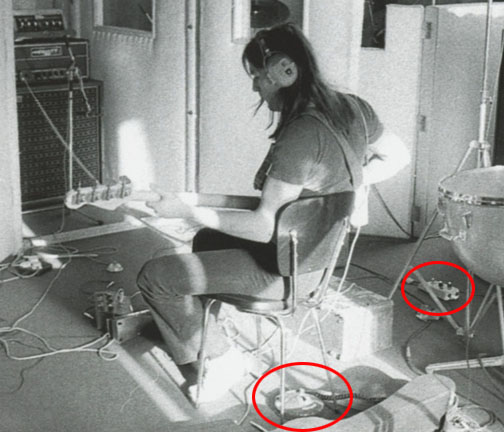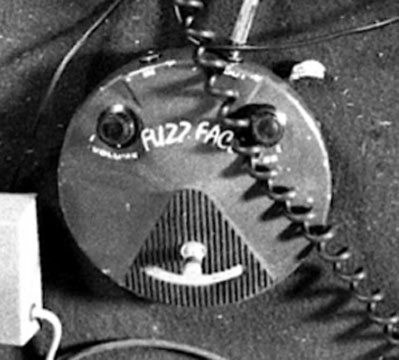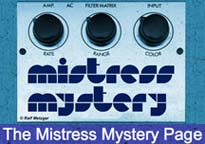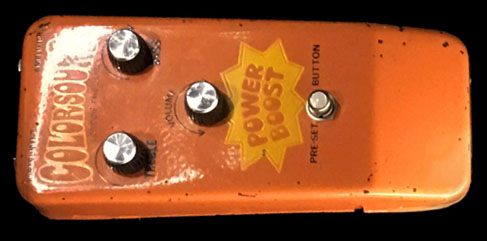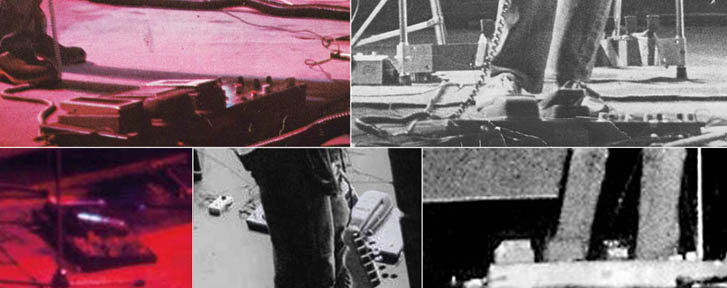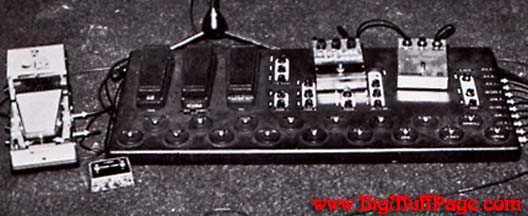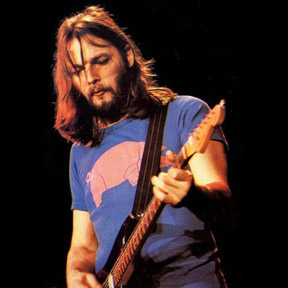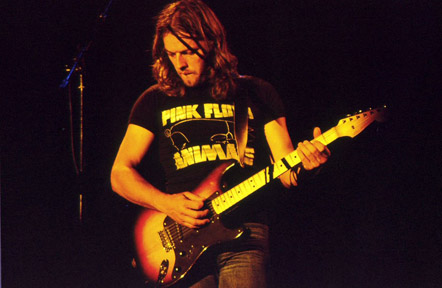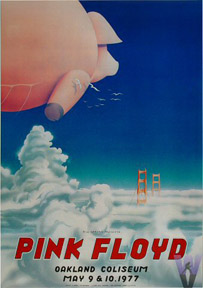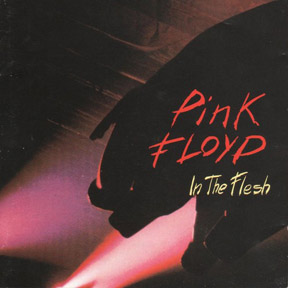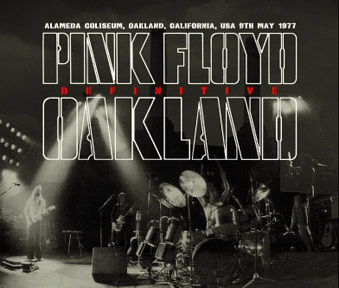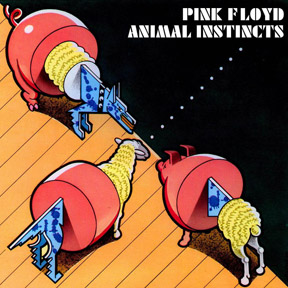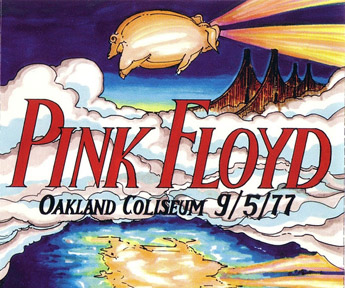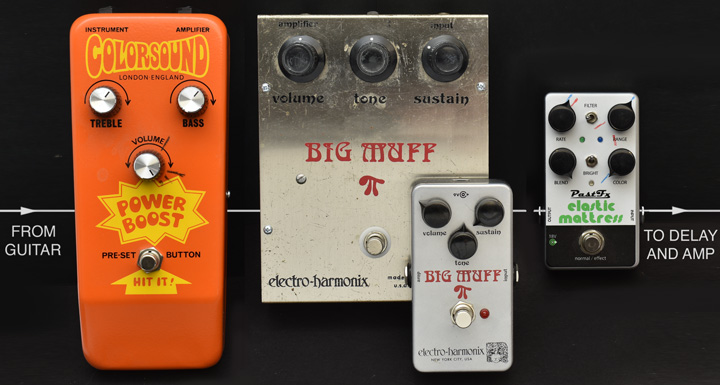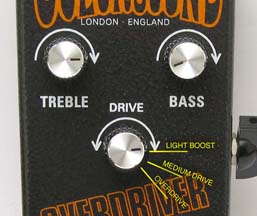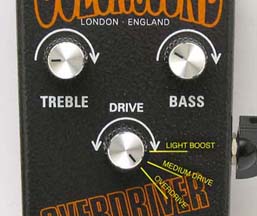NOTE: This website is frequently updated. Article written 2007. Last update April 2023 |
The COLORSOUND POWER BOOST and OVERDRIVER - PAGE 2 |
|
Shown above - David Gilmour's Power Boost settings from Pink Floyd's 1977 tour rehearsal (left) and his recording DAVID GILMOUR POWER BOOST TONES - David Gilmour of Pink Floyd used several overdrive pedals throughout his musical career, with the 18v Power Boost and BK Butler Tube Driver being his favorites. Nothing has quite that same classic Pink Floyd overdrive tone like the Colorsound Power Boost/Overdriver, especially through a Hiwatt amp like the Custom 50 or Custom 100. However, what most people do not realize is that the Power Boost is also a fuzz pedal, on par with the Fuzz Face, and David sometimes used it as such. In fact, I think some of those classic 1970s Pink Floyd high gain guitar solos are actually the Power Boost, not the Fuzz Face. David used the 18v Power Boost from 1972 to late 1977 and it is the primary overdrive used on the albums Obscured by Clouds, Wish You Were Here and Animals. It can be heard prominently in nearly every song, but particularly on such tracks as Shine On You Crazy Diamond, Have A Cigar, and Sheep. Although David owned a Power Boost in 1972 there is no documentation of him using it for the recording of Dark Side of the Moon, but one can be seen in the 1972 photos of the Obscured by Clouds recording sessions, just prior to the Dark Side sessions, and it can be heard in several places on that album. I happen to think it was used in conjunction with the Fuzz Face for the Time and Money solos from DSOTM, and I hear it in Brain Damage and the early mixes of Eclipse. You can even hear David using what I beleive is the Power Boost in the studio clip of him playing fills for Brain Damage on his Lewis guitar from the Pink Floyd Live at Pompeii film.
Below are some examples of David's use of the Power Boost in Pink Floyd from 1972-1977.
The prime example of David's use of the Power Boost is Pink Floyd's 1975 album Wish You Were Here. The Power Boost is all over that album, especially in the two versions of Shine on Yoiu Crazy Diamond, which feature layers and layers of guitar parts showcasing the wide range of sounds achievable with the PB and a Strat. Here is a selection of guitar parts from that album.
David also used the Power Boost heavily on Pink Floyd's 1972-1977 Pink Floyd tours. The full-on overdrive fuzz sound of the Power Boost and the Power Boost + Big Muff and Electic Mistress can be heard very prominently in audience recordings from Pink Floyd's 1977 tour. A Fuzz Face was also used on that tour, but I beleive many of the high gain distortion tones were the Power Boost running at full power and the Power Boost+Big Muff combo, with the Power Boost being the dominant fuzz in that combo.
The Colorsound Power Boost or Overdriver can be used for light to heavy orverdrive with the volume/drive knob set anywhere from 12:00 to 3:00. It can also be set for a light drive and placed before or (or after, depending on settings) a Fuzz Face or Big Muff pedal to EQ and increase the sustain and dynamics. I use it for the clean tone and many of the overdrive tones for songs from Dark Side of the Moon and Wish You Were Here, and as a light boost and EQ before my fuzz pedals like the Analogman Sunface BC108 Silicon fuzz. Where the 18v Power Boost version shines is as a fuzz pedal though. When the volume knob is set to maximum, the treble set to 1:00 or higher, and bass to 12:00 or lower, it can nail the solo tones in Obscured by Clouds, Have A Cigar, the slide solo in Shine On You Crazy Diamond, the Pigs solo, and the dry solo in Dogs, among others. The Power Boost alone, or blended with a Big Muff and Electric Mistress, can recreate many of David guitar tones from the Columbia Records live promotional videos David made for his first solo record in 1978. The treble-boosted fuzz from the Power Boost is very distinct when used with the Big Muff in this way. David Gilmour's 18v Colorsound Power Boost (left) used in Pink Floyd's Obscured by Clouds recording sessions in 1972
David Gilmour using the 18v Colorsound Power Boost on stage with Pink Floyd in the Netherlands in 1972.
Colorsound Overdriver beside David Gilmour's pedal board used for the the La Carrera Panamericana WHICH IS THE BEST, THE POWER BOOSTER OR OVERDRIVER? - That all depends on which original or which reissue version you have. I list all the versions I know of on the previous page. For basic boosting EQ and light overdrive, practically any of them will work. For the high gain lead fuzz tone heard in places like the Dogs dry solo and the Have A Cigar solo, I think only an original Colorsound 18v Power Boost, or Colorsound Vintage Series 18v Power Booster reissue nails that sound. The Standard Series 9v reissues just do not cut it. They do not have enough distortion and are missing that amp-like fuzz quality, but they can get close if you use high output pickups like the Seymour Duncan SSL-5 or DiMarzio FS-1. The only 9v version I have played that comes close to the 18v sound with regular Strat pickups is the Colorsound Vintage Series Overdriver made my Stu Castledine for Macaris. Stu also makes the Vintage Series 18v Power Boost for Macaris (still being made when I updated this in 2019). None of the Power Boost/Overdriver clones I have tried nail that sound either, although a few get very close, like the Buffalo Power Boost. USING THE POWER BOOST/OVERDRIVER WITH A HIWATT - The pure Colorsound 18v Power Boost sound is all over the Obscured by Clouds and Wish You Were Here albums, so I have experimented with various settings on my Hiwatt amps and Power Boost /Overdrivers to replicate those tones. The PB is finicky when the volume pot is dialed into maximum overdrive fuzz, and some amp settings do not work very well with it. The settings that sound best to me are David's mid 1970s Hiwatt settings, taken from a photo of his amps in 1974. Keep in mind that if you run the PB as a fuzz at maximum volume like this, you cannot run the Hiwatt master volume too high or it will go into uncontrollable feedback. I have to keep the master set 9:00-10:00, or lower, to keep it right on the edge of feedback. my Reeves Custom 50PS settings for a mid 1970s Gilmour tone my Hiwatt Custom 100 settings for a mid 1970s Gilmour tone Also, keep in mind that when David used the PB in the studio in the early 1970s, his guitar typically went straight into the PB, then into his Binson Echorec, then into the amp. There were not lots of buffered pedals before and after the PB in his signal chain like on our modern pedal boards. Buffers are not necessarily a bad thing, but they do affect the tone and amount of distortion generated by the PB. There was actually an input buffer in the Binson Echorec, so you are hearing the sound of the PB through a buffer already in most of those Pink Floyd recordings. I explain how buffers affect the circuit on the previous page, but suffice it to say, a buffer following the PB can actually make the PB overdrive sound a bit smoother. I do not like the sound of a buffer before the PB however, so when I use it, the PB is always first in line after the guitar. Below is an example of the guitar going straight into Power Boost - no buffers. Below is an example of the Power Boost with a buffered pedal in front of it. Note that the tone has changed and become more nasal sounding.
The Power Boost and Overdriver settings that work best vary depending on which version of the pedal you have. I have found that the settings on the Colorsound Standard Series 9v Power Boost and Overdriver do not correspond to settings on the Vintage Series 18v Power Boost reissue, or the original 18v Power Boost like David used. I suspect that is due to the larger headroom of the 18v version. With the drive pot set to maximum, the Vintage Series versions and originals also have a richer and more amp-like distortion than the Standard Series versions I have used. It's like a mix of fuzz and overdrive, where the the Overdriver reissue is missing the "fuzz" part of the sound. The Vintage Series Overdriver settings are close to my Power Boost settings below. Some Standard Series reissue Overdrivers have a different drive pot value, so settings on that version may not match what I show here. Below are the settings I use that have a matching tone on each. overdrive settings for 18v Power Boost and 9v Overdriver When starting off using the Power Boost/Overdriver for overdrive, I suggest setting the volume/drive pot on the pedal to maximum, with the treble high and bass low, then dial your guitar volume down slightly to get the level of overdrive you are trying to match. If you want it smoother, dial the volume/drive pot on the pedal down slightly. Dialing the guitar volume down slightly gets into the overdrive slide guitar tones heard in Burning Bridges, Childhood's End, the rhythm and lead overdrive tones heard in Childhood's End, Syd's theme (SOYCD Part II) and the chorus and verse sections (SOYCD Parts III, IV, VII), as well as the rhythm overdrive tones heard in Pigs, Dogs, and Sheep from the Animals album. Here are a few clips of the 18v Power Boost used for light and medium overdrive.
maximum fuzz settings for the 18v Power Boost For that classic Pink Floyd lead fuzz tone - heard in Obscured by Clouds, the Have a Cigar solo, the slide guitar from Shine On You Crazy Diamond (SOYCD Part VI), and possibly the Dogs dry solo and Pigs solo - set the volume pot to maximum and treble to 3:00 or higher. I set the bass to 12:00 or lower, but adjust it to the level needed for the particular tone. Set your guitar volume to maximum or just below to hit the sweet spot. That will vary depending on how hot your pickups are. As stated above, you need an 18v Power Boost for this, but some 9v versions may work if you use high output guitar pickups, which compensate for the lower headroom gain of the 9v circuit.
(left) Gilmour during the Obscured by Clouds recording sessions with a Power boost and Fuzz Face. (right) One of several Fuzz Face pedals owned by Gilmour in 1972. POWER BOOST + FUZZ FACE - The 18v Power Boost/Overdriver can also be blended with a Fuzz Face (or clone based on that circuit like the Analogman Sunface) through a Hiwatt to replicate the lead solo tones on heard in songs like When You're In, The Gold It's In The..., and Free Four. You can also use just a Fuzz Face for those tones, but I have found I can get closer to the album sounds when blending the two pedals and using the PB to EQ and boost the tone. This works best with regular output single coil pickups, like the type in Gilmour's Strats at the time. High output pickups like the Seymour Duncan SSL-5 are more difficult to control. The sound you get can aso vary quite a bit depending on the fuzz pedal used. The Power Boost needs to be first in line after the guitar, followed by the fuzz. Guitar volume is the key to controlling this setup, and the guitar on full is often NOT the best sound. Dial the guitar volume to 5 or 6, set the Power Boost volume to zero and distortion level on your fuzz pedal to zero. Dial the fuzz distortion up to the desired level (about 12:00 on my Fuzz Face or Sunface), then adjust the guitar volume until you hit the sweet spot. Some of the fuzz tones on the Obscured by Clouds album, like When You're In, have the treble boosted high on the Power Boost. I dial it to maximum for those songs. You can get some very smooth lead and overdrive tones blending both pedals this way, although it can be a bit noisy. For solos like Time, and Money, I also run the Power Boost or Overdriver first in line after the guitar, followed by the Fuzz Face. I leave the Power Boost on all the time and switch on the Fuzz Face for the solos, with the guitar volume backed of slightly. The extra boost from the Power Boost drives the Fuzz Face a little harder, giving it that additional gain and screaming tone I hear in those 1972-74 Pink Floyd live and studio recordings. Set the Power Boost volume around 10:30-11:00, the bass at 12:00, and Treble at 1:30-2:00. Set the Fuzz Face fuzz control to maximum and the volume to unity. Sometimes there is an impedance mis match between the PB and some fuzz circuits, causing the tone to sound too harsh and trebly when blending the two. This can often be fixed by adding a buffered pedal in between the Power Boost and the fuzz pedal. Any pedal with an always-on buffer will work, like a Boss pedal. Using a buffer like this can also make the disortion more controllable and smoother. That is my preferred setup for blending the PB with a fuzz, and what I am using in the clip below.
POWER BOOST + BIG MUFF - The 18v Power Boost can also be blended with a Big Muff through a Hiwatt. It creates a sound like something in between a Big Myff and a Fuzz Face. As with the Fuzz Face combo above, it is best to have the PB first, running into the Big Muff. The PB distortion drives the Muff, rather than the other way around with the PB+Fuzz Face. Set the PB drive to maximum and the Big Muff sustain very low, then adjust the guitar volume until you hit the sweet spot. This setup works well with the gutar straight into the PB, or with a buffered pedal between the guitar and PB. Using a good clone of the 18v PB with a master volume also works well combined with a Big Muff in this manner. I have tested it with the Buffalo 18v Power Booster and the Past FX 18v Power Booster. Other than having to dial the Big Muff sustain slightly higher, they sound nearly identical to the Colorsund 18v Power Boost when blended with the muff. Below are a few examples using this setup to replicate a few of the Dogs solos from the Animals studio recording. This is the PB wide open, with the muff used as an EQ and to add slightly more gain to the PB fuzz.
HOW DID DAVID GILMOUR USE THE POWER BOOST LIVE? - One of the major drawbacks to using the original 18v Power Boost is the massive volume boost when activated. It is so loud that it is impossible to make it have a unity volume with other pedals or effects in a typical pedalboard signal chain, as it will always be louder than practically everything else when engaged, even with the volume/drive knob at its lowest setting. The 9v master volume versions of PB and Overdriver are better, but also too loud to work on a modern pedalboard unless both the volume and drive knob are dialed to zero. If you set the Hiwatt master volume high like David did live in the early 1970s, it is practically impossible to use the stock PB as a fuzz pedal in a live situation. There is so much headroom and volume from the PB slamming into the DR103 preamp that you get nothing but uncontrollable feedback. I have to set Hiwatt master volume to around 9:00 or lower to make it work, and even that is still right on the edge of feedback. One of David Gilmour's original Colorsound Power Boosts. This is one of the later production without the "Hit It" arrow graphic, circa 1972 So how did David Gilmour actually use the Power Boost in his live rigs from 1972-1974? I think it was mostly used as an alwasy-on pedal for his clean tones, and he used the volume knob on the guitar to go from clean to light overdrive. He was rarely, if ever, switching the pedal off. David only had a few pedals in '72-73 - a Power Boost, Fuzz Face, Vox Wah, Uni-Vibe, and a DeArmond Volume Pedal, in that order. If you run the PB first in line with the volume at 12:00 or lower and set the Fuzz Face volume close to maximum, both pedals are at unity volume, as are all the pedals that follow when either one is switched on. When David wanted to use the PB for light overdrive in a song, he just had to dial the guitar volume up. When he wanted fuzz leads, he would dial the guitar volume slightly below maximum and kick on the Fuzz Face. That simple setup, along with his Uni-Vibe and delay from his Binson Echorec, were how David achieved almost all of his live tones in that period. For the wider range of overdrive and Fuzz tones heard in the 1974-75 period, I think David was using the Power Boost and Fuzz Face pedals individually, and combined. For fuzz leads, he would dial the guitar volume up, switch the PB off and Fuzz Face on, or run both at the same time if he wanted the maximum gain. If he wanted light overdrive, he used the Power Boost. If hea wanted heavy overdrive, he used the Fuzz Face and dialed the guitar volume down. Becasue of it's massive headroom, he could never dial the PB volume up to use it as a fuzz pedal in this setup, but he had the Fuzz Face for that. Shown above - David Gilmour's custom integrated pedalboard (made by roadie Chris Adamson) with built in Colorsound Power Boost from 1973-75. In 1973 Gilmour had a Power Boost circuit incorporated into a custom made, integrated pedal board that he used when performing live. We do not know the signal chain order for that board, but I presume the PB was placed first in line, as he was doing on stage prior to the custom pedal board. If you set the PB for slightly dirty boost, turning the Uni-vibe on with it creates an overdrive-like distortion. Dial the Uni-vibe Intensity knob to 50% or less, so the vibe effect is minimized, then switch on a Fuzz Face with fuzz knob dialed down to around 40% and you have vintage 1974 Pink Floyd tones. Alternatively, you can set the Power Boost drive to 12:00 or less and run it into the Fuzz Face with the fuzz knob on maximum, then kick on the Uni-Vibe. Doing this can replicate the Fuzz Face_Leslie roating speaker tones heard in the Empire Pool, Wembley concert recorded in London 1974, found on bootlegs and the live concert from the Dark Side of the Moon Immersion Edition. That Fuzz Face+Leslie sound can be heard in the Time solo from the Wembley concert below.
One other way to make the PB work live is to modify it with a master volume pot or a fixed resistor to reduce the level to a more manageable unity volume. Effects builder Pete Cornish incorporated a Power Boost circuit into a large integrated pedalboard that he built for David in 1976, for use on Pink Floyd's upcoming 1977 tour. Cornish would have modified the PB circuit so the level was in unity with the bypassed volume and balanced with the other effects in the signal chain. Based on the numerous bootleg recordings of Pink Floyd's 1977 tour, David used the PB often, could turn it on at off as needed, and it was clearly at unity volume with the other effects. Cornish even made his own version of the Power Boost with a master volume mod in late 1977, the ST-2 Treble and Bass Booster. It actually replaced David's Colorsound unit when his pedalboard was updated in October 1977, according to Cornish (Guitar World magazine 2006). Pedalboard photos from Gilmour's Medina studio in 2017 show a 10k master volume pedal in line after the PB. It was built specifically by Pete Cornish to allow the PB volume to be brought down to unity.
Shown above - David Gilmour's 1977 Pete Cornish made pedal board with built in Colorsound Power Boost from Pink Floyd's '77 tour rehearsal There are very few photos around showing David's PB settings. Pedalboard photos from Gilmour's Medina studio in 2017 shows a volume setting of 12:00. One photo from the 1977 Pink Floyd tour rehearsals shows the PB treble set to 1:00, bass at 2:30, and volume knob set almost to minimum, for a lightly overdriven clean tone. However, most of the high gain distortion heard during the tour sounds like the PB at maximum fuzz overdrive volume. It has that distinct treble-boosted fuzz sound., and it was a noticeably hotter sound than the previous tours, which I think was due to the DiMarzio FS-1 bridge pickup in David's Black Strat at the time. The FS-1 had a much higher output than the stock pickup he had been using previously. I cannot get the Power Boost to sound that intense with my standard Strat pickups, but it definitely can with the hotter FS-1 or Seymour Duncan SSL-5 pickups.
1977 LIVE LEAD TONES WITH THE POWER BOOST AND BIG MUFF - One of the most popular guitar tones among older Gilmour tone enthusiasts like myself are his high gain lead tones from Pink Floyd's 1977 tour. Although there were no official live recordings released by the band - and it appears that no multi tracks were even recorded in 1977 - there are numerous audience recordings that are very good, including the excellent Oakland California recording from May 9th. It has been circulating under various names like Oakland Coliseum, In the Flesh, Plays the Animals, Animal Instincts, and Animal Instincts rev B, which is the best version for Gilmour's guitar tones, in my opinion. That recording is by far one of the best in audio quality, rivaling a soundboard, and the performances are good, but there are also other recordings of better performances from the tour that have very good audio. One of my favorite 1977 shows is Boston Gardens, MA, from June 27th, particularly the PRRPSAE two-source stereo matrix (Hopkins and Lampinski recorders). Some other great performances are Madison Square Garden in New York City from July 2nd, Paris from Feb 26th, Fort Worth Texas from May 1st (Iron Pigs on Fire), and Anaheim California from May 7th (Sirene recorder 2). The last show of the tour in Montreal Canada on July 7th (Who Was Trained Not to Spit On The Fan) also has some of the best performances of the tour.
Floyd performed both Animals and WYWH on this tour, with some Dark Side songs as encores, and lots of extended instrumental jamming. David's guitar tones were very different from previous tours, due to the use of his new Electro-Harmonix Electric Mistress flanger and the Yamaha-RA-200 rotating speaker cabinets that he used to color his guitar sound for most of the songs. His sound was also much more aggressive than anything that had come before, even for the older Pink Floyd songs that were performed. This was mostly due to the heavy use of the Power Boost, and the PB+Big Muff. Below are a few medleys of Gilmour's guitar work from those concerts. A few of these clips are the Power Boost with the drive set to maximum, running into a Big Muff with the sustain set very low, but I believe many are of these clips are just the PB alone.
Below is another example from the 1977 tour. The Power Boost is first, then David switches on the Big Muff at the 12 second mark. I believe this Power Boost + Big Muff combo was the primary high gain lead tone for the tour.
Below is a sound clip from Pink Floyd's 1977 tour where you can first hear the Colorsound Power Boost set for moderate overdrive, then at the 24 second mark David turns on his Big Muff and the sound explodes. The Power Boost is clearly set to a lower volume than when the Power Boost+Big Muff are combined. This is something not possible with the stock Power Boost unless the circuit has been modified to bring the level down.
What was the signal chain order for these tones? The PB came after the Fuzz Face and the Pete Cornish custom Big Muff in the signal chain, but it came before the send/return with David's 1974 Ram's Head Big Muff and Electric Mistress in a loop. You can get similar 1977 live tones by running the Big Muff into the Power Boost or the Power Boost into the Big Muff. It's that PB into the Big Muff/Mistress signal chain that sounds more accurate in my rig, and that is what I think David used for most for his high gain sound on that tour. I also think it sounds best if the guitar goes direct to the Power Boost, with no buffer in between. Guitar > Power Boost > Ram's Head Big Muff > Electric Mistress > Delay When that Cornish pedal board was revised in 1979, the Fuzz Face and Muff were both placed before the Power Boost in the chain, and David's lead tones changed, leading me to believe that the PB+Big Muff combo was probably unique to the '77 tour, and not used after. Some evidence for that is the small Pete Cornish boards David used for the second half of The Wall concerts in 1980-81. They had a Big Muff built into them, but no Power Boost. The PB and Big Muff settings for this setup will vary depending on what type of Power Boost you use, but for an 18v PB, I set the drive to maximum, treble around 1:00, and bass around 12:00-1:00. I set my Ram's Head Big Muff with the tone knob around 12:00 and sustain almost off. The PB is the dominant fuzz, and the Big Muff is used as more of an EQ and gain boost for the signal. Use the guitar volume to control how heavy you want the distortion. An Electric Mistress flanger is also critical for this sound, and it really needs to be one of the old green large box EM's from the 1970s, or a good clone that matches that early bright EM sound. The Past FX Elastic Mattress and Retro-Sonic Flanger are two very good substitutes, and more sonically accurate than EHX's own Electric Mistress reissues in the small XO sized enclosures, the Stereo Electric Mistress and XO Deluxe Electric Mistress.
My settings to replicate David's high gain lead sound from the 1977 Pink Floyd tour. The modern EHX Ram's Head Big Muff Below are a few sloppy sound clips of my 1977 tones using the PB and Big Muff, with a Past FX Electric Mattress flanger and 300ms delay from a Free the Tone Future Future Factory. Telecaster into a Reeves Custom 50.
Below is an example of my 1977 lead tone setup. This is a Strat with an SSL-5 bridge pickup, 9v Colorsound Overdriver running into a Ram's Head Big Muff, through a Fender Twin Reverb. The Overdriver drive pot was set to nearly maximum gain and the Big Muff sustain is set around 60%. If I were use use the 18v Power Boost for this, I would set drive to maximum and the Big Muff sustain to nearly zero.
EVIDENCE? - I have to point out that there is no documentation of what songs David Gilmour used the Power Boost on for Pink Floyd's 1973-75 concerts or the 1977 tour, or how he used it. David has never really talked about it in interviews. It's all guess work, based on the sound. It is generally assumed that the Power Boost was used for most of David's overdrive sounds in that 1973-77 period, but it is also possible to get similar overdrive tones from the Fuzz Face by dialing the guitar volume down and/or dialing the fuzz level down on the pedal. Add in modulation effects that David used, like a Uni-vibe, phaser, Electric Mistress flanger, or rotating speaker cabinets like the Leslie or Yamaha RA-200, and it becomes very difficult to identify what we are hearing. That said, there is a signature sound to the Power Boost through a Hiwatt that is different from a Fuzz Face or a Big Muff, so if you are familiar with those differences it is sometimes easy to identitfy which pedal was being used. As far as the Power Boost-into-Big Muff combo, there is zero evidence that David did this, other than my ears. I have tried every way to use a PB, Fuzz Face, and a Ram's Head Big Muff. I have tested numerous ways to combine them, various settings, and every signal chain order possible. The only way I can achieve those heavy 1977 lead tones is with the PB+Big Muff, so I am convinced that is what David was doing. David also used a Cornish custom tone pedal in his '77 pedal board that was essentially a Telecaster tone circuit wired to a Cry-Baby wah wah chassis. It is unknown how or when he used this pedal, but that is another possible element of those 1977 tones to unravel. The Tele tone circuit is just a varaible resistor and a capacitor, the same as a Strat tone circuit, although the capacitance value may have been slightly different between David's Strats and Teles. Dialing the tone down on a Tele when using a Fuzz Face or Power Boost, and dialing the treble higher on the amp creates a unique tone, similar to Eric Clapton's "woman tone". I do hear some of the high end rolled off the top in David's '77 tones, but that can be done using the guitars tone control, so it in unclear how this tone pedal was used. CLONES - There have been numerous, less expensive clones made of the Power Boost/Overdriver over the years that include built in master volumes. Too many to list or keep up with, but Gilmourish.com always has a good llist of the alternatives available. A few clones I have tried that sound good are the Throbak Overdrive Boost, Vick Audio Overdriver, Buffalo FX Power Booster, Past FX 18v Power Booster, Vintage FX Colordrive, and Prescription Electronic RX Overdriver. Most of these sound like they were inspired by the originals and do not sound exactly like the Sola Sound pedals I own, but are very close. The 18v Buffalo FX Power Booster is one of the better ones. The Past FX Power Booster is basically the same pedal in a smaller enclosure. Boss BD-2 Blues Driver also gets in a similar tone and overdrive territory as the Colorsound Power Boost. Below are older sound clips from a previous version of this webpage. Soundclips of Pink Floyd's David Gilmour using the Colorsound Power Boost SOUNDCLIPS - Clips below are played with a 2008 American Standard Strat, Fender CS69 neck pickup and SSL-5 bridge pickup, into a '65 Fender Twin Reverb RI. Colorsound Overdriver Rhythm Demo - Pigs Colorsound Overdriver Demo - Shine On You Crazy Diamond Colorsound Overdriver Demo - On An Island MORE SOUND CLIPS - Fender strat with SSL-5 bridge pickup into Overdriver, MXR Carbon Copy analog delay, and Fender Twin Reverb. Colorsound Overdriver Sound Clip 1 - Colorsound on light boost playing Money bass line. Colorsound Overdriver Sound Clip 2 - Colosound on light overdrive playing Time solo. Colorsound Overdriver Sound Clip 3 - Colorsound on maximum overdrive playing Time solo. NOTE - I have listed the gear and settings I use in most cases, for reference, but note that the tones may not exactly match your rig, depending on which amp you use, your guitar, and pickups, and fingers :) |
|
Kit’s Secret Guitar, Gear, and Music Page VISIT MY SWORDS, KNIVES and FANTASY ART WEBSITE www.kitrae.net |

